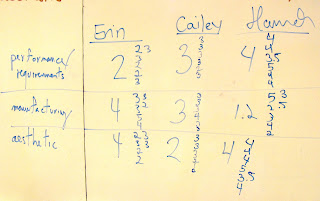Erin is working on a page with a basilisk (2nd Book) whose eyes light up and are controlled by a photo resistor such that the user of our pop-up can turn-off the basilisk's eyes with their finger. Kelsey is working on a hippogriff with movable wings (3rd Book) which will be a page focusing more on pop-up design/ paper engineering. My page will show Bellatrix with a movable arm so that she can touch her wand to her dark mark. On the other side of the page we will have a light-up dark mark in the sky.
Our entire book will be supported by a cardboard lid we found in the engineering lab. The flat top of the lid will have the pages fastened, and our circuits will pass through the lid to the back where we attached two breadboards to handle all our circuitry. I exacto-knifed a hole in the side so that our power supply can pass through the side (we chose to do this over attaching eight AA batteries, which is what would have been necessary to power our pop-up).
Shown below is our circuit with two red and green bicolor LEDs which we will attach to our Hogwarts pop-up in the final scene between Harry and Voldemort.
For anyone unfamiliar with the Harry Potter series, my page features Bellatrix and the dark mark tattoo as seen below:
http://heidihastings.deviantart.com/art/Bellatrix-190292381
The Dark Mark in the sky:
http://images4.wikia.nocookie.net/__cb20110401033142/harrypotterwiki2/images/3/3d/Dark_Mark.jpg
Buckbeak the Hippogriff:
http://darksuperpuffyclouds.webs.com/photos/null/buckbeak.bmp
The Basilisk:
http://www.fearnet.com/eol_images/Entire_Site/20101018/HP02_basalisk.jpg






























